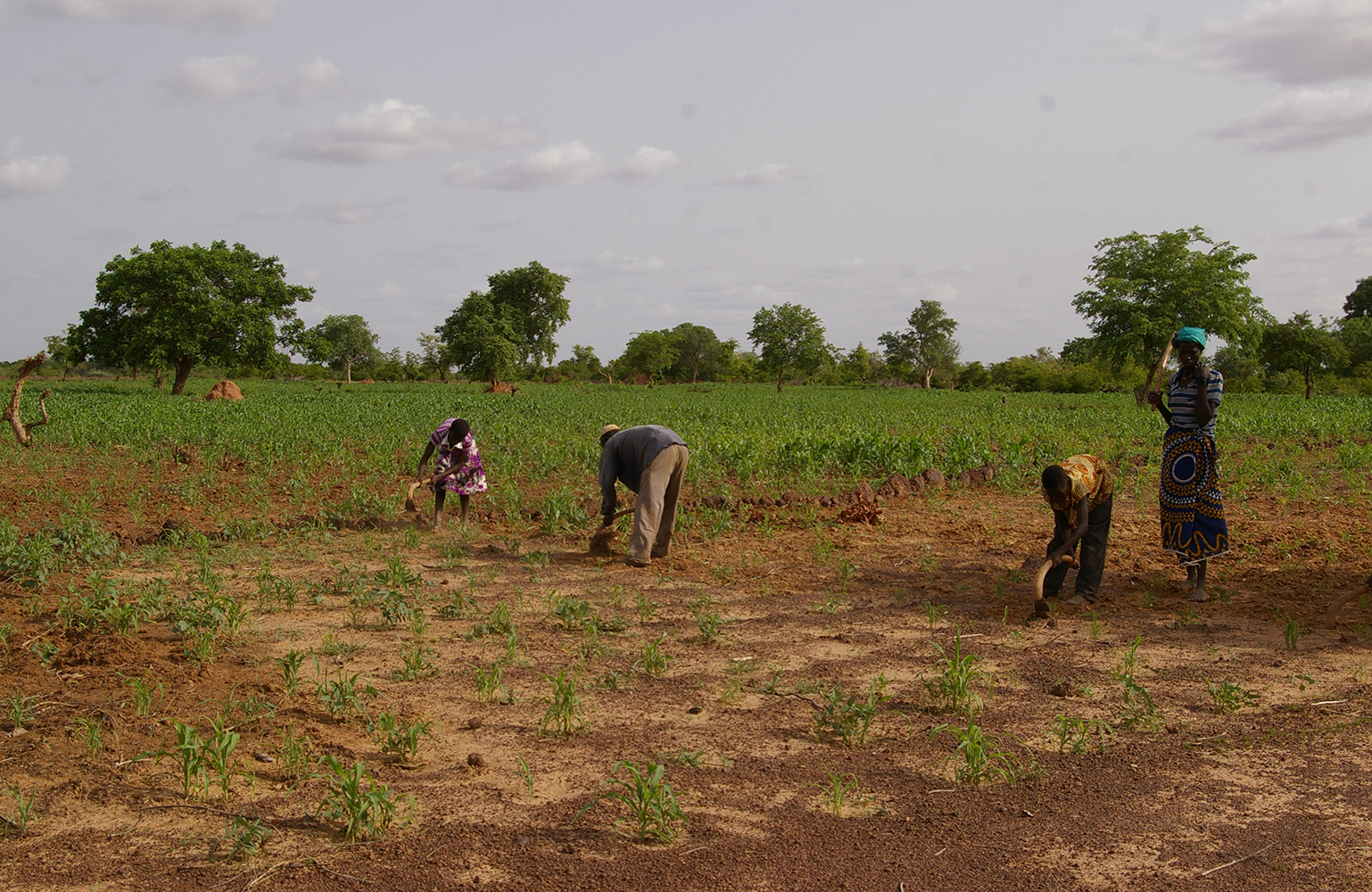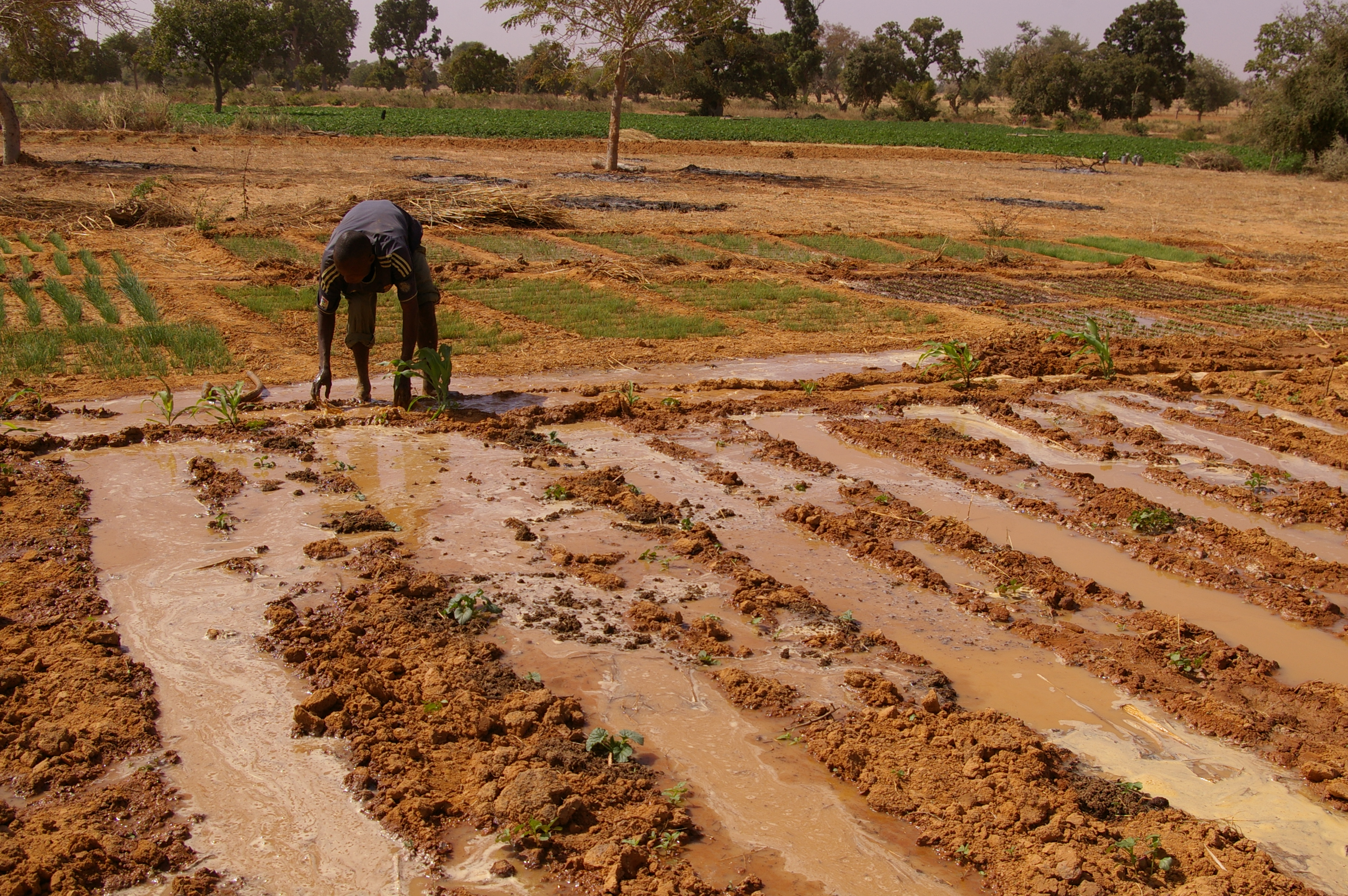The rain is still falling gently after yesterday evening’s long-anticipated thunderstorm. On a late morning in July the soil smells good after the heavy rainfall, and giant red velvet mites crawl across the red-brown fields, searching for smaller bugs to eat in the recently tilled fields.
I am here with my hosts, the Savadogo family, who live in a small village outside Ouahigouya in northern Burkina Faso. They are thinning and weeding their millet field. The two older sisters, not yet in their teens, are carrying umbrellas to protect the youngest family members, wrapped in colourful cloth on their backs. The sons have been up since morning prayers at 4.30 a.m., after which they brought the sheep to graze in the outskirts of the village before starting their work in the fields.
The millet has reached a height of about 30 cm by this time in the growing season. Yesterday’s rainfall came just in time to give hope to the Savadogo family and their neighbours that this will be a good season with a good harvest. Last year, the rainy season started badly and they had to re-sow their crops at the end of July. Normally, sorghum and millet are sown in mid-June.
Rainfall patterns here have changed and become more unpredictable for the Savadogos and their community. At the same time the dependence on rain-fed agriculture is stressed in all the villages I visit for my research: “S’il n’y a pas de pluie il faut que nous fuit aller ailleurs,” farmers tell me (“If there is no rain, we need to flee and go somewhere else.”).
In this part of Burkina Faso, about 90% of the population relies on agriculture as their main livelihood.
See all references
Despite adopting new practices that have improved their harvests, the people of this region live in poverty and are facing uncertainty brought by a shifting climate.
One uncertainty is the unpredictability of rainfall, but this is only one of the reasons why people are changing how they depend on the landscape. Other opportunities are presenting themselves, especially for young people, yet the middle-aged farmers I talk to cannot imagine giving up their livelihoods. Even office workers buy land as a kind of insurance, so that they might be able to farm when they retire and possibly feed or support themselves.
These communities wonder what the future will bring. Researchers, including myself, are only starting to weave together some of these threads and what they mean for the future of food production in the Sahel.
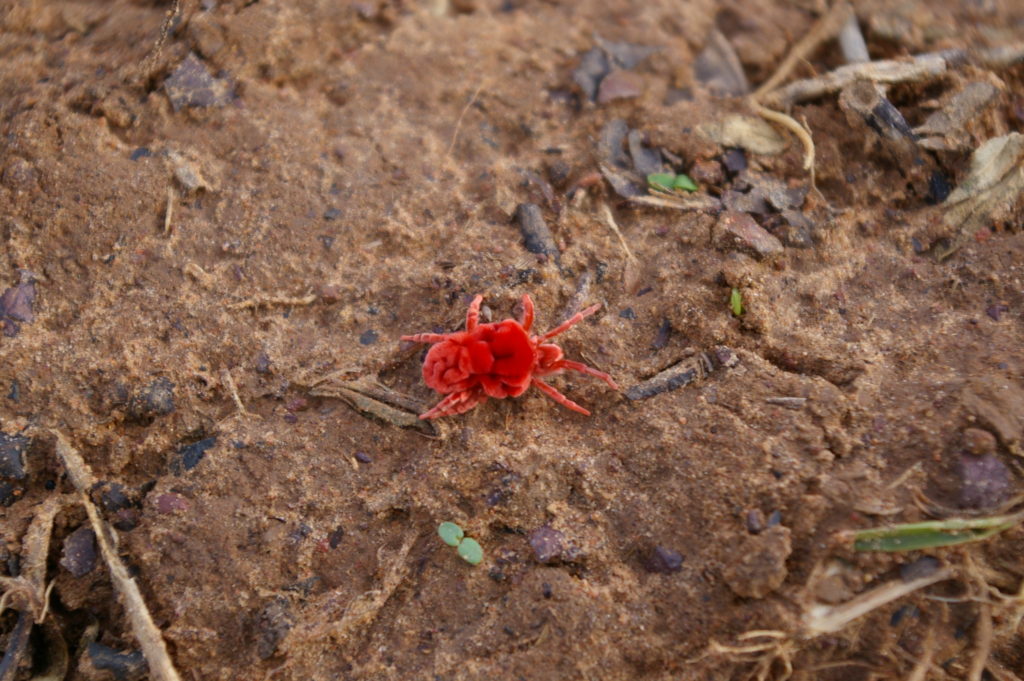
A giant red velvet mite, about two centimeters long with furry back and arachnid legs, looks for prey in the fields after the rains. Copyright: Hanna Sinare.
Improved yields, but continued poverty
Like other farmers in the region, the Savadogo family has been using improved soil and water conservation techniques for a long time. These techniques were developed from traditional practices in collaboration with non-profit organisations such as Oxfam, and local organisations supported by international donors such as USAID and the World Bank, working in the Ouahigouya area during the 1980s. The goal of these projects was to improve conditions for farmers after the severe droughts that struck the Sahel in the 1970s and early 1980s.
See all references
Farmers most commonly use improved versions of traditional planting pits (zaï). They dig holes with a diameter of 15-20 cm and a depth of 10-15 cm, excavated in a grid on the fields. They add manure or compost to the pits before planting cereal seeds, so that rainwater and nutrients are concentrated around the cereal plant.
See all references
These pits are used in combination with stone bunds – lines of stones that run perpendicular to the slope of the field – which decrease the speed of the water flowing on top of the soil during the heavy rainfall events and allow it to infiltrate the soil.
The father of the Savadogo family is calm and reflective. He is active in the local community and participates in different projects that non-profit organizations bring to the village. Currently, he takes part in a study comparing the yields from fields with different configurations of zaï. He also has been to training sessions in Ouahigouya in how to construct “half-moons” to reclaim degraded soil for cultivation. These structures are used in the same way as zaï, but are half-moon-shaped, with a diameter of up to 4 m. The Savadogo family and a few others are the only ones to use this practice in the village. Digging the half-moon structures in hard degraded soil is exhausting, and constructing just one takes several hours.
These techniques – the zaï, the stone bunds, and the half-moons – have helped improve productivity on farmers’ fields and reclaimed degraded soil.
See all references
Their success has led to their spread from farmer to farmer, as well as through projects and organised training. While the techniques improve yields, they are not enough to make yields reliable or to bring people out of poverty.
Yields of sorghum and millet in the Ouahigouya area have increased from around 500 kg/ha in the mid-1980s to around 900 kg/ha today.
See all references
Yields across the country vary a lot between years, and are still among the lowest in the world. In Burkina Faso, 45% of the population lives under the $1.25-per-day income poverty line.
See all references
Techniques that improve crop yields are part of addressing poverty in the country, but will not be enough in the face of multiple interacting changes.
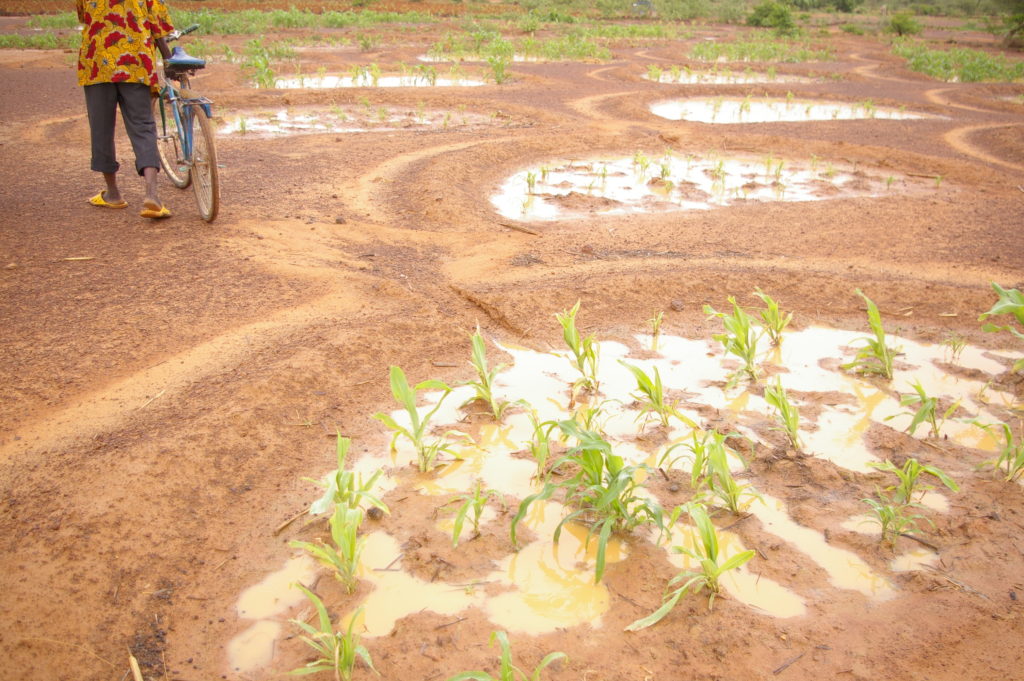
Half-moons with sorghum just after a rainstorm in July. Copyright: Hanna Sinare.
Landscape patchwork
People in the Sahel have always depended on local landscapes for their livelihoods. A walk through a village landscape will take you through a patchwork of fields with scattered trees and shrubs, shrublands where livestock graze, and some areas of bare soil.
Just behind the Savadogo family’s field a gentle slope rises, covered with scattered shrubs and small acacia trees. The millet fields often start just behind the houses that make up a family dwelling compound, and the stalks of the growing millet plants rise 2 to 3 m high before the end of the rainy season. Vegetable plots, for daily cooking, surround courtyards of packed soil, ringed with small houses made from clay bricks and granaries woven from tall grass.
Some fields are left fallow to regain soil fertility, but this practice is increasingly rare, as the high population density forces people to cultivate every hectare of land available. In most villages you eventually walk through a lower lying area that gets temporarily flooded in the rainy season. The fringes of these depressions have richer soils, and the yields there are often higher than from other fields.
Each of these patches – the fields with trees, shrublands, homesteads, fallowed fields, and depressions – provide overlapping but distinct sets of resources. In fields with dispersed trees, for example, people plant and harvest millet, sorghum, peanuts, and cowpeas. But they might also gather fruits from trees on the same fields: for example, shea fruits that can be processed into cooking fat or for use in cosmetics, and baobab leaves for the sauce that accompanies the staple food tô, a thick porridge prepared from sorghum or millet flour.
“S’il n’y a pas de pluie il faut que nous fuit aller ailleurs.” (“If there is no rain, we need to flee and go somewhere else.”)
Farmers in northern Burkina Faso
The shrublands are sources of firewood, construction materials, traditional medicine, and fruits. Livestock move across the whole patchy landscape. They are kept away from fields during the cropping season, but allowed to eat anything left over after harvest. They graze and browse on the shrublands, seek water in the depressions, and are kept close to the homesteads at night.
During years with too little rain, people rely more heavily on the landscape for its non-cultivated resources – but not necessarily for their own direct consumption. Instead, they use them to gain cash income.
See all references
For example, livestock become especially important in these dry periods, to be sold when there is dire need. Livestock animals may provide some milk, but are mostly kept as a kind of insurance; they move across the whole village landscape, and it takes several years to build up the herds, meaning that people cannot use the strategy of selling their animals every year. The multiple resources that people use for their livelihoods, for example through livestock roaming all parts of the landscape, means that their resilience to meet dry years when they lose crops is dependent on the entire landscape around their villages.
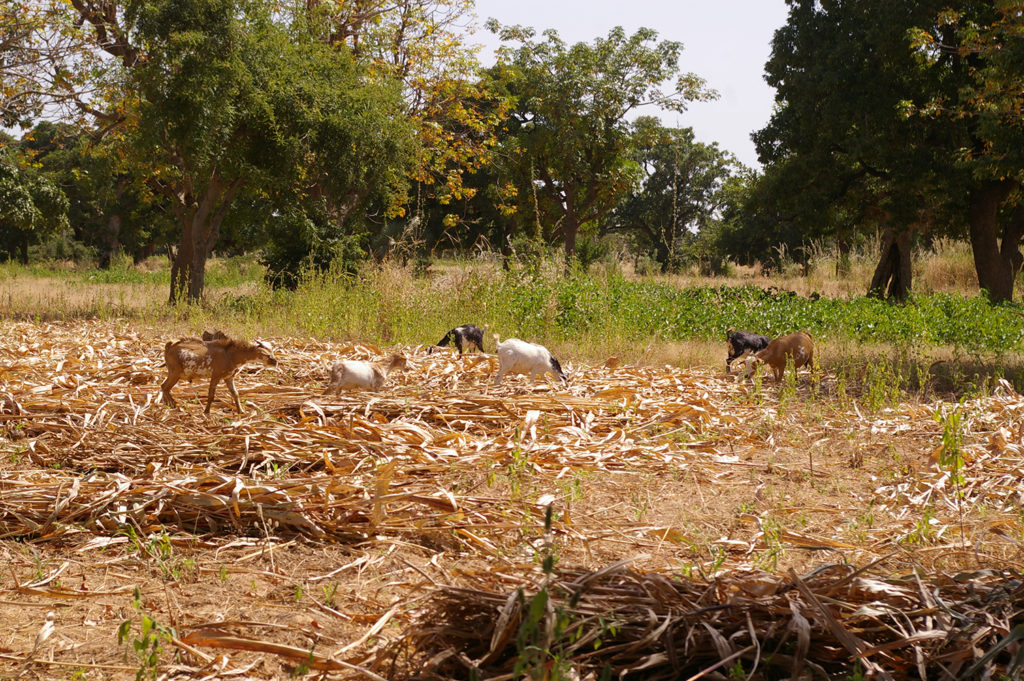
Goats eat the leftover remnants of crops close to a depression in a village near Ouahigouya. Copyright: Hanna Sinare.
As landscape productivity depends on rain, people also depend on rain. Rainfall depends on climate, and the climate is changing. At the same time, consumption patterns, market prices, and opportunities to sell products in markets are changing.
See all references
This means the benefits people reap from the landscape are also changing.
Farmers have become more concerned with getting cash income, and are gradually shifting away from traditionally dominant crops – millet and sorghum – which are mostly consumed by their own households. They are allocating an increasing part of their land to cash crops such as peanuts and cowpeas. Farmers prefer to be able to buy a bag of maize flour, rather than depending on a staple crop that might fail.
Unreliable rains
Three years after that July rainfall, I am back in northern Burkina Faso. It is January 2016, in the middle of the dry season. I sit with a group of about 20 farmers in the shade outside a little shop in a village near the small city of Kaya. The cloud-free sky is hazy from the dust blowing in from the north and from the Sahara desert with the Harmattan wind.
The farmers express their concerns about a more unreliable rainy season: Over the past ten years, the rains have become more intense. The volume of water that falls has increased, but it seems to come in massive bursts, with dry spells in between. The new rainfall pattern is not good for their crop yields, as the rains do not last for the full growing season; the crops need water from June to October to grow well. Too much rain in short bursts also damages the crops – whole fields can be lost in a day, the farmers tell me.
These concerns are shared by the government. “What we have observed regarding the rainy season is a tendency that the average rainfall has increased, while the period covered by the rainy season has decreased,” an officer at the regional office of the ministry of environment and sustainable development in Kaya tells me.
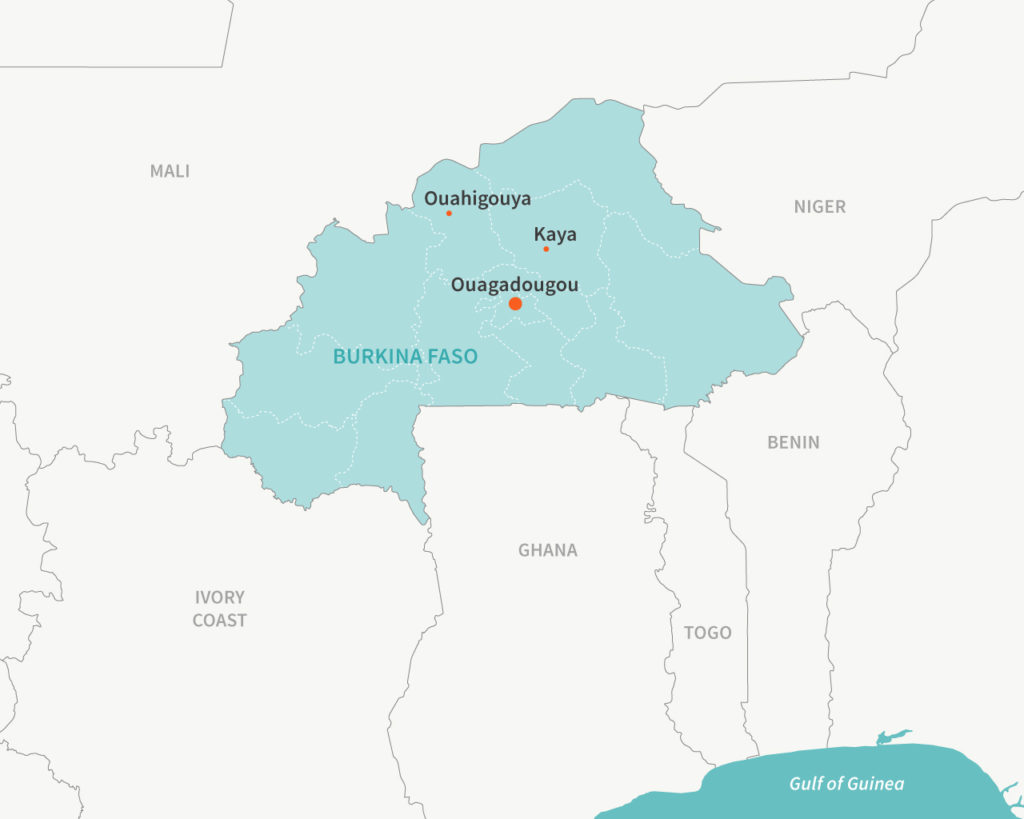
Map of Burkina Faso. Illustration Elsa Wikander/Azote.
These observations are also supported by scientific studies of the Sahelian climate. After the droughts that struck the region in the 1970s and 1980s, the yearly rainfall has recovered since the 1990s, but with large variation in rainfall between years. This recovery of average yearly rainfall has not been accompanied by an increase in the number of rainfall events, which means fewer and more intense storms.
See all references
The rainy season now has a different and more challenging character.
It’s more common for the rainy season to begin with a “false start”, with rainfall events followed by a period without rain. Farmers plant their crops, as the season seems to have started, but unless more rain comes in time the crops die and need to be replanted. The rainy season also ends earlier, while more of the rainfall events are very intense, increasing the risk for flooding. Global climate change is likely to strengthen these “new” rainy season patterns, not alleviate them.
Many challenges for the future
Models for how rainfall will change in the Sahel region do not generate consistent projections. While models predict increasing temperatures, they produce diverging results for changes in rainfall, both in how much it will change and if the total rainfall per year will increase or decrease.
See all references
This means that farmers face large uncertainties for their future livelihoods. Because such a large proportion of the population depends on agriculture, many people’s livelihoods will continue to rely strongly on rainfall in the near future.
At the same time as the climate is changing, people’s habits and aspirations are changing. They are eating more processed food and eating out more often.
See all references
More young people are enrolled in education and are continuing at school to achieve higher levels of education. Their aspirations are changing as they become better educated and connected with the greater world, as communication across the globe becomes easier and faster with better internet and wider use of mobile phones. Young people do not necessarily want to farm anymore. But researchers are only starting to grasp the magnitude of these changes and how they will affect agriculture across African nations.
See all references
Given the challenges described here and their complex interlinkages, what would a sustainable food production system look like in the Sahel in the future? For agricultural development interventions to work, what would it take to convince innovative young people to engage in agriculture, and what kind of agriculture would that be?
Water availability and irrigation techniques are one factor. Different types of irrigation systems for vegetable production, including small reservoirs, have increasingly been adopted in Burkina Faso over the past 15 years.
See all references
In a village outside Kaya, north-east of the capital, a small reservoir was constructed in 2009 and farmers have recently recognised the potential to gain income from using that water during the dry season, to grow, for example, potatoes, onions, and tomatoes to sell to buyers from Kaya.
Rural youth who farm in North Africa seem to be most engaged in irrigated cultivation of vegetables, as it is more profitable than other types of agriculture.
See all references
Even urban youth turn to agriculture when inspired by good science teaching, which gives them an increased understanding of the social and economic role of agriculture.
See all references
Other changes could also attract more young people to agriculture, according to responses from secondary school students in Ghana: increased mechanisation, better provision of services in rural areas, and a greater respect for farmers in society.
See all references
But even in areas where young people want to farm, for example in Ethiopia, they may not be able to get access to farmland, which is limited as population grows and where regulations limit ownership or use. Such lack of access is a key reason for young people in Ethiopia to look for other ways of making a living.
See all references
Aspirations and the opportunities to realise them – not least for young people – must be considered when planning interventions for poverty alleviation. After my meeting with the farmers that January day, two of them show me the vegetable cultivation around the reservoir some kilometres from the village centre.
I walk in between plots of tomatoes turning from light green to red in the sunshine, aubergines about to start flowering, and knee-high potato plants. My guides fill a sack with onions and cabbages for my translator and me to take when we leave.
Will these plots be more common in village landscapes in the future? Who would I meet if I were to walk through the landscape ten years from now, and what will the landscape patchwork look like? Changed, I assume, with changing rainfall, people’s changing aspirations, and ever more interconnected changes.

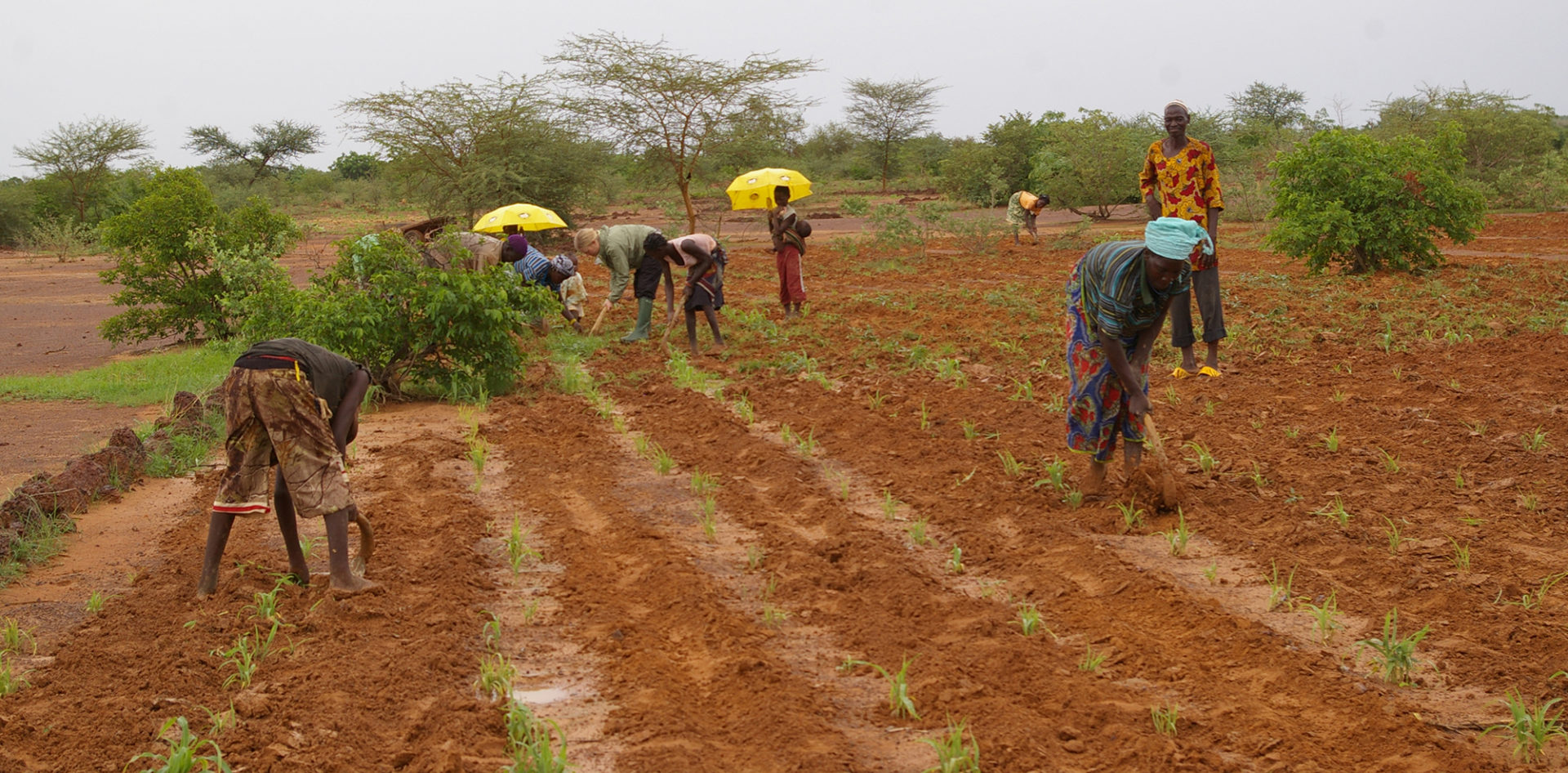
 15 MIN READ / 2489 WORDS
15 MIN READ / 2489 WORDS
